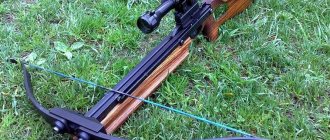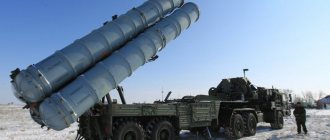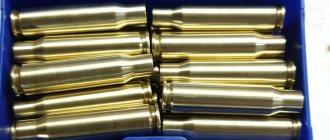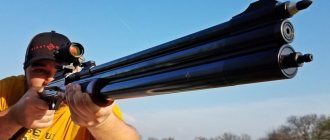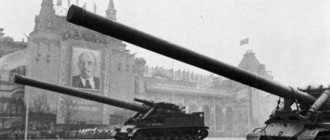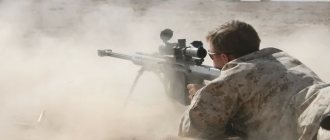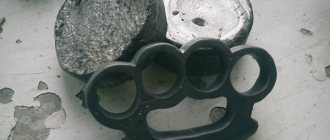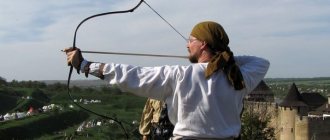Medieval crossbow
The first historically confirmed data on crossbows dates back to 400 BC. According to one version, China is considered its homeland, according to another - Greece. It can be assumed that the combat crossbow appeared in both the East and the West at approximately the same time.
Ancient crossbow: replica.
In medieval Europe, the crossbow reached its peak of popularity in the 12th to 16th centuries. When defending castles, it was a more effective weapon than a bow. The chronicles of those years describe the battles of English, French, German and other troops, in which the crossbow is mentioned.
The first guns had a very simple design and short range. They were made of wood. Only a warrior unprotected by armor could be hit with an arrow fired from such a crossbow. Over time, the design has undergone improvements. When making weapons, animal tendons, horns, and metal were used.
Starting from the 12th century, special belt hooks began to be used to tighten the bowstring. This made the difficult task easier for the shooter. goat’s leg came into use - a lever that catches the bowstring. The crossbowman pulled the lever towards himself, and the bowstring tightened.
Crossbow arrows were different from bow arrows. They were more massive, heavier, and had tetrahedral tips.
With the advent of firearms, the crossbow gradually lost its relevance, but it has not yet been possible to completely supplant it.
https://youtu.be/zWlFASPc1-A
English gate
The English gate is an adaptation for really powerful crossbows. They cocked it and fired it like this:
Let's take a closer look at this type of crossbow. So, here is the crossbow itself, with the collar removed:
As you can see, the system is simple: with the help of a winch, the hooked bowstring is pulled back and the crossbow moves into the firing position. No more difficult than getting buckets out of a well.
And here is the gate itself separately:
Despite the name "English" this one was made in Switzerland or Germany. Dating: 16th century. The type of crossbow mechanism did not mean at all that it was not used outside a particular country - absolutely not. Everyone chose weapons for themselves or their soldiers based on their own considerations.
Pros of English Gate
The device is definitely excellent and reliable. If you change the rope in a timely manner and maintain the mechanism of the English gate, such a crossbow will not be demolished. But there are also disadvantages.
Cons of English Gate
Firstly, such a crossbow cannot be reloaded quickly. Less powerful types - with a “goat leg” or even the simplest ones, with a belt hook, were much faster in firing. Therefore, they were preferred to be used in battles in open areas, while the English gate was used in the defense of fortresses.
Secondly, the more complex the design, the more fuss the master has with it, and the ropes can get tangled. So everything is as always - the more powers, the more responsibilities.
The design and principle of operation of a crossbow
A crossbow is a bow mounted on a stock (base) and equipped with additional mechanisms for tensioning the string, releasing the trigger, and aiming.
The principle of operation has remained unchanged since ancient times.
- The cocked bowstring is fixed in the lock, and an arrow (bolt) is placed in the stock guide.
- The shooter takes aim, pulls the trigger, releasing the bowstring.
- The arcs straighten, and the bowstring forcefully pushes the arrow towards the target.
Device:
- The stock is the base to which all parts of the device are attached. Made from wood, plastic, metal. The stock also has a guide for the crossbow bolt.
- Shoulders – arcs to which the bowstring is attached. They accumulate mechanical energy for firing. Material for production: wood, metal. In ancient times, tendons and horns of cattle were also used.
Crossbow: device. - The trigger mechanism ensures retention and release of the bowstring. On simple devices it can be in the form of a wooden trigger. On more complex models, a cased metal trigger mechanism is installed.
- A bowstring is a rope made of strong threads or metal attached to the shoulders. In places of friction on the bowstring, a braid is made. Modern string threads are Kevlar, Dacron, Dacron. Metal cables are also used.
- A block or cross is a fastening for arcs. It experiences heavy loads, so it is preferable to use high-strength steel as the material for its manufacture.
- Sights – ensure shot accuracy. There are optical, dioptric and open.
Features of the law
Even after amendments are made, the document does not provide a clear answer to all questions. However, he clarified a number of points that were previously outside the legal framework.
Thus, throwing hunting weapons received legal status and are completely legalized. The official purchase process may look overly formalized (obtaining the ROH, registering with the National Guard, etc.), but bowhunters no longer need to look for legal loopholes to use bows and crossbows.
After the amendments were made, it became clear that hunting throwing weapons are subject to the same standards and rules that are mandatory for firearms.
The bowhunter must have a hunting permit, a permit for the extraction of biological resources, an open permit and other documents, comply with the limits, permitted periods of hunting and other legal requirements. Next > Still have questions?
Types of crossbows for hunting
The preferred types of crossbows for hunting depend on the preferences of the shooter and the conditions in which it will be used.
If this is a short-term trip, then a compact compound crossbow is quite suitable. If this is a long hike, then you should give preference to the reliability of recursive weapons.
There is an opinion that a compound crossbow is better than a recurve crossbow because it is more powerful and has a faster rate of fire. But this is a controversial proposition.
When compared, it is clear that both devices have sufficient arrow speed for use in hunting.
Recursive
A recurve crossbow is the very device that the average person imagines when they hear the word “crossbow.” Its shoulders bend in the direction opposite to the pull and are connected by a bowstring.
When cocked, the bowstring bends its arms, increasing the tension force until it locks into the trigger mechanism. At this moment the castle is under the greatest load. When fired, the bowstring is released, transferring the energy of the arcs to the projectile.
Features of the recurve crossbow:
- Thanks to the lightness of the shoulders, the device is lightweight, and the center of gravity is shifted to the butt. This makes it easier to aim and fire.
Recurve crossbow. - Simplicity of design ensures reliability. They are less likely to fail because they have a minimum of parts.
- No block settings required.
- Easy to maintain.
- They have wider dimensions compared to block ones, which can make transportation difficult.
- With the same tension values in the block and recurve devices, in the recurve device the arrow has a lower take-off speed.
Blocky
In a block crossbow, there are special blocks at the ends of the arcs, onto which cables are wound when the bowstring is pulled. These cables bend the shoulders and distribute the load so that the lock bears about a third of it. When the bowstring is released, the blocks rotate, giving the arrow additional acceleration.
Peculiarities:
- High power with little effort.
Block crossbow. - Compact dimensions.
- The lock is not subject to overload, the descent is carried out gently.
- Thanks to the blocks, it is easier to tighten the bowstring.
- The center of gravity is slightly shifted towards the shoulders, which can make aiming difficult.
- They have a complex structure and therefore require more thorough repairs. It is impossible to repair such a device “on the knee”.
- Requires special block settings.
Samson's belt
The inventor of the Samson belt just slightly modernized the belt hook using a roller. The rest of the design worked the same way: hooked - pulled - cocked.
With the invention of the Samson belt, it became possible to use crossbows with a tension of over 100, but not more than 180 kilograms. The force that the shooter applied to cock the crossbow was half the force of the bowstring.
There were also regional differences. For example, the Italians used rope in their design, and the Germans used a wide strip of leather. The latter option seems to be more durable.
Main selection criteria
First of all, you need to decide for what purpose the weapon is being purchased. Hunting crossbows must have high destructive power. For sports shooting, models with high accuracy are preferred. For entertainment and study purposes, inexpensive, lightweight devices with average performance are quite suitable.
When choosing, you should pay attention to the following indicators:
- Power or tension force. Devices with a capacity of no more than 43 kg are allowed on the territory of the Russian Federation.
- Bowstring stroke. The greater the distance between the bowstring in the free position and in the tension, the greater the power and range of the shot.
Crossbow. - Convenience . The weapon should be comfortable to use, as light as possible.
- Availability of parts. You need to ask if there are spare parts for the selected weapon on sale, so that if necessary, you can replace a broken part. Otherwise, you will have to buy a new crossbow.
- Availability and cost of ammunition. Arrows are a consumable item, so it is worth asking about their price.
German Gate - Kranekin
And finally, the last type of crossbow for today is a crossbow with a German collar. Again, the name “German” is conditional, especially since in France there was a special word that was used to designate the crossbow itself - “kranekin”, and the shooters with it “kranekinje”.
Kranekins appeared at the beginning of the 15th century. Speaking in modern engineering language, a cranekin is nothing more than a rack and pinion gear mechanism. It consisted of two gears - large and small, as well as a gear rack and a long handle.
The shooter hooked the bowstring with a gear rack and twisted the handle. The reika moved and pulled the bowstring along with it.
The most powerful
Kranekin was as complex as it was effective. Judge for yourself: if you twist the cranekin mechanism with a force of 1 kilogram, you can easily cock a crossbow with a tension force of 103 kilograms!
Later, even more powerful cranekins appeared, which made it possible to cock even more “tight” crossbows.
The heaviest
Kranekin is compact, efficient and reliable. However, it is heavy - two kilograms is half the weight of a Kalashnikov assault rifle, and we still have a whole crossbow. So you can’t run much with the German goal.
This weight is quite understandable - in order to draw a powerful crossbow, the tensioning means must be appropriate. Therefore, if the mechanism and the crossbow are not equal to each other - say, the crossbow turns out to be more powerful than necessary, then the bowstring can easily bend it and render it unusable.
Safety precautions
A crossbow is a dangerous weapon. In order to protect yourself and others, you must adhere to the following safety rules:
- A crossbow with a drawn bow is considered loaded.
- It is prohibited to fire blank shots.
- Before shooting, it is necessary to check all components of the weapon and the condition of the arrows.
- It is forbidden to keep your finger on the trigger until aiming.
- It is prohibited to talk, be distracted, or move while aiming and shooting.
- It is prohibited to transfer a loaded crossbow.
- The line of fire must be clear of people and animals. You need to make sure that if you miss, the arrow will not hit a live target.
- It is prohibited to shoot upward.
- Do not leave unattended, especially within the reach of children.
- The weapon must be stored unloaded.
- Do not touch the stretched bowstring
- Safety glasses should be used.
Belt hook
When trees were large and crossbows were not as powerful as in the Renaissance, the back muscles were used to cock the crossbow. To do this, the crossbowman put on a special belt, from which a specially shaped hook was suspended.
With this hook, the shooter hooked the bowstring, and inserted his bent leg into the stirrup. Now all that remained was to straighten the leg and straighten the back so that the bowstring of the crossbow was taut.
Thus, the rate of fire increased, because if you can still cock the crossbow with your hands for a couple of shots, then during the battle you will not be limited to this. Accordingly, with each shot the rate of fire should decrease.
In the future, other types of crossbows with much higher tension will appear. This means that mechanisms will be required that will allow them to be cocked with much less effort. The very first device that made it possible to obtain maximum results with a minimum of effort was the “Samson belt”.
How to shoot a crossbow correctly
Sequencing:
- Manufacturing.
- Breath control.
- Aiming.
- Shot.
Shooting positions:
- Shooting while standing. The shooter's left side is turned towards the target. The main support is the legs. They are shoulder-width apart, the weight is distributed evenly on both legs. The right hand holds the butt, the left holds the stock. Your back should be slightly tilted back for balance. The head is turned in the direction of shooting, held straight.
- Shooting with support on the knee. The support is the right knee and the feet of both legs. The left shin should be vertical to the ground. The elbow of the leading hand rests on the left knee, the right hand holds the butt.
- Prone shooting. The most stable position, the whole body serves as support. The legs are relaxed and spread apart for stability, the right one is slightly bent. The left hand, holding the forend, is half-bent and extended forward, the right hand holds the butt, the elbow touches the shooting line.
In each position, the butt rests against the right side of the sternum at the collarbone. To avoid injury, you should be aware of recoil after a shot.
Shooting while standing.
Kneeling shooting position.
History of creation
Historians cannot agree on whether the crossbow was invented in Ancient Greece or Ancient China. It is likely that this happened in Europe and Asia almost simultaneously.
Gastraphetes - ancient Greek crossbow
The idea of inserting a stick between the center of the bow arc and the tensioned bowstring so that you do not have to hold the tension with your hands while aiming is almost trivial. It could very well come to the minds of many at the same time.
But the crossbow became truly in demand around the 11th century. In those days, the typical nature of military operations changed. Many feudal wars were fought around the defense and capture of the stone castle-fortresses that then appeared everywhere. It was for the defense of fortresses that this weapon was ideally suited. The difficulties of its combat use in an attack are that the crossbow limits the warrior’s mobility: it requires time to reload and leaves the shooter defenseless at this moment. In the defense of a reliable stone fortress, the situation is different. Reloading takes place in safety, under the cover of a stone wall. The crossbow is an excellent defensive weapon. The period from the 11th century to the 16th century marks the era of the crossbow. It ended only with the advent of firearms into military practice.
Characteristics affecting arrow range
It is advisable to divide the entire variety of factors influencing the firing range into the following groups:
- Anthropogenic. These include the general physical condition of the owner and the level of development of his shooting skills.
- Constructive : type, speed and mass of the arrow, the presence of sighting devices.
- External ballistics factors: wind direction and speed, weapon elevation angle.
- Target factors : mobile or fixed, its size.
Arrow trajectory when fired
A crossbow of any design sends an arrow along a steep trajectory. This is primarily due to the relatively low speed of the arrow: hunting models give it an initial speed of about 120 m/s with a mass of about 27 g. For such an arrow the formula is valid: for every 5 m the trajectory decreases by 3-7 cm, and the speed drops by 1-3 m/s.
Crossbow for hunting.
Without stock and barrel
Crossbow stocks, that is, that part of them that the shooter held with both hands, were made of hardwood. They were made from walnut, pear, apple, and so on.
It is also very important that the shape of the stock did not at all resemble a rifle, as it is now.
Roughly speaking, it was just an elongated rectangle, devoid of both the trigger and the butt, in the modern sense.
The bolt moved along the upper plane of the stock, which was called a lug and which was often equipped with a guide groove.


